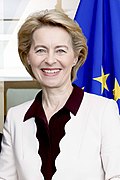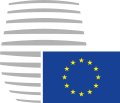Portal:European Union
Introduction
The European Union (EU) is a supranational political and economic union of 27 member states that are located primarily in Europe. The union has a total area of 4,233,255 km2 (1,634,469 sq mi) and an estimated population of over 449 million as of 2024. The EU is often described as a sui generis political entity combining characteristics of both a federation and a confederation. Containing 5.5% of the world population in 2023, EU member states generated a nominal gross domestic product (GDP) of around €17.935 trillion in 2024, accounting for approximately one sixth of global economic output. Its cornerstone, the Customs Union, paved the way to establishing an internal single market based on standardised legal framework and legislation that applies in all member states in those matters, and only those matters, where the states have agreed to act as one. EU policies aim to ensure the free movement of people, goods, services and capital within the internal market; enact legislation in justice and home affairs; and maintain common policies on trade, agriculture, fisheries and regional development. Passport controls have been abolished for travel within the Schengen Area. The eurozone is a group composed of the 20 EU member states that have fully implemented the EU's economic and monetary union and use the euro currency. Through the Common Foreign and Security Policy, the union has developed a role in external relations and defence. It maintains permanent diplomatic missions throughout the world and represents itself at the United Nations, the World Trade Organization, the G7 and the G20. In 2012, the EU was awarded the Nobel Peace Prize. In 2020, the United Kingdom became the only member state to leave the EU; ten countries are aspiring or negotiating to join it. (Full article...) Selected article€2 commemorative coins are special euro coins minted and issued by member states of the Eurozone since 2004 as legal tender. The coins typically commemorate the anniversaries of historical events or draw attention to current events of special importance. Eighteen variations of €2 commemorative coins have been minted. €2 commemorative coins have become collectibles. The basis for the commemorative coins derived from a decision of the European Council, which repealed the prohibition of changing the national obverse sides of euro coins from 1 January 2004 onwards. The face value of the coins, typically is less than their intrinsic value of between €3 and €12. The exceptions are San Marino and the Vatican City, where coins from the former are regularly sold for between €30 and €40, while coins from the latter are very rarely obtained for less than €100. Issued designs are made public in the Official Journal of the European Union. Selected picturePhotograph credit: Uoaei1 Aggstein Castle is a ruined castle on the right bank of the Danube in Wachau, Austria. It was built in a strategic position on a rocky crag in the 12th century, but little of the original structure remains. In 1429, it was razed and rebuilt by Jörg Scheck von Wald, and the three-storey women's tower, the palace and the Gothic chapel date back to this period, as does the famous rose garden. Anna Freiin von Polheim und Parz carried out renovations in the early 17th century, but after her death, the building deteriorated and stones and timber were removed for use in the construction of a nearby Servite convent.
Did you know?...that within the Eurozone the European Central Bank has the exclusive authority to set monetary policy? ...that Greenland and United Kingdom are the only countries to ever leave the European Union? Selected cityLjubljana is the capital and largest city in Slovenia. The city of Ljubljana is the cultural, scientific, economic, political and administrative center of Slovenia. It is situated in central Slovenia, between the Alps and the Mediterranean. The city is divided into several quarters, formerly municipalities, the main ones being Šiška, Bežigrad, Vič, Moste, and Center, which also correspond to the main electoral constituencies of the city. Its transport connections, concentration of industry, scientific and research institutions and industrial tradition underlie its leading economic position. Ljubljana is the seat of the central government, administrative bodies and all government ministries. It is also the seat of Parliament and the Office of the President of Slovenia. General imagesThe following are images from various European Union-related articles on Wikipedia.
TopicsFeatured contentFeatured articles
Featured lists
Featured contentGood articles
CategoriesRelated portalsAssociated WikimediaThe following Wikimedia Foundation sister projects provide more on this subject:
Discover Wikipedia using portals |



































































